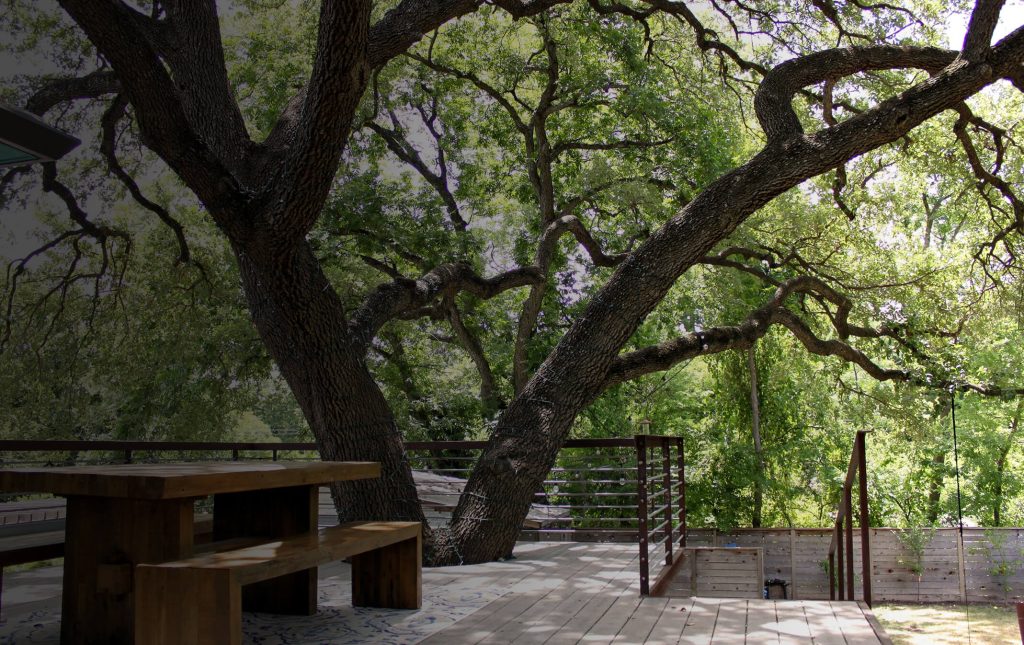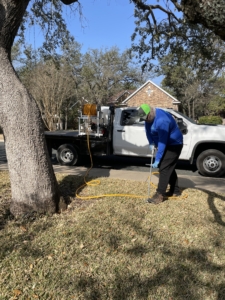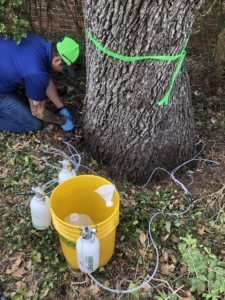Cedar Creek Tree Services | Complete Tree Care By Specialists
- Tree Removal, Tree Planting, and Tree Trimming
- Certified Arborists
- Emergency Services
Call Today to Schedule an Appointment. 512-212-0010
Call Today to Schedule an Appointment. 512-212-0010
Cedar Creek continues to grow quickly—bringing new homes, schools, and commercial spaces to the area each year. With that growth comes a unique set of tree care challenges. Older neighborhoods are home to mature live oaks and red oaks that need careful pruning, while newer developments often struggle with compacted soil, shallow planting, and fast-growing trees that lack structural support. Add in seasonal storms and the rising spread of oak wilt, and it becomes clear that routine tree healthcare services are essential for long-term safety and value.
At Happy Tree Service of Austin, we provide certified arborists and science-led care tailored to Cedar Creek’s evolving landscape. Whether you’re preserving a canopy that’s been there for decades or starting fresh on a new property, our ISA Certified Arborists help you make decisions that support safety, longevity, and curb appeal. We don’t just trim or remove trees—we partner with property owners to protect what’s growing and prevent future issues before they arise. As a trusted commercial tree service company, we bring the same attention to detail to HOAs, businesses, and residential clients alike.

Tree care isn’t just a task—it’s a science. And in a place like Cedar Creek, with dense subdivisions, drought-prone summers, and increasingly unpredictable storm seasons, professional guidance makes all the difference. That’s why so many turn to us as their dependable tree trimming company and tree removal company.
Our arborists are certified arborists by the International Society of Arboriculture and have more than three decades of experience working with native trees across Central Texas. We understand how live oaks, red oaks, cedar elms, and other species respond to the region’s soil conditions, seasonal shifts, and stressors like drought and wind exposure.
We’re proud to offer oak wilt diagnosis and treatment by trained, certified professionals. Our team includes specialists qualified in both Oak Wilt and Tree Risk Assessment—giving us the tools to identify disease, evaluate structural stability, and help homeowners manage canopy safety with confidence.
From scheduling to execution, our team works with professionalism and care. We show up on time, respect your property, and keep workspaces clean throughout the job. Every estimate we provide is clear and detailed—no pressure, no upselling, just honest advice and certified tree care.
Cedar Creek presents a range of site conditions. Some lots sit on rocky fill, others have clay-heavy soil or drainage issues near sidewalks or foundations. We understand how these variations impact root health, canopy development, and tree longevity—and we adjust our approach accordingly to keep your landscape safe and healthy.

Tree pruning is one of the most important things you can do to maintain the health and safety of your trees. But it has to be done correctly. Our trimming services in Cedar Creek focus on improving structure, reducing weight in the crown, and ensuring safe clearance from buildings, walkways, and roads—all while respecting the natural form of the tree.
Thinning the inner canopy allows air and sunlight to pass through, reducing the risk of fungal infections and helping grass and garden plants below thrive. We remove select interior limbs to reduce density without compromising the tree’s shape or stability. This technique is especially helpful for species like live oak and cedar elm that develop thick interior growth.
Overhanging limbs can damage roofs, block sight lines, or restrict sidewalk access. We trim back limbs safely, creating space between trees and structures while avoiding over-pruning that could lead to regrowth or instability. Our crews work around fencing, driveways, and utilities with care and precision.
For younger trees or fast-growing species planted in new developments, we provide structural pruning to establish balanced canopies and reduce future maintenance needs. For older trees with heavy limbs, we reduce weight in key areas to prevent breakage and maintain structural integrity.
We never top trees or perform excessive thinning that strips the interior of the canopy. These practices can lead to rapid, weak regrowth and long-term damage. Every cut we make is purposeful, properly placed, and guided by ANSI A300 pruning standards.
We look beyond immediate appearance to guide how trees will grow over time. Whether you’re managing a row of street trees or a single oak in your backyard, we trim to promote healthy growth patterns that reduce risk and enhance canopy beauty for years to come.
While we prioritize preservation whenever possible, there are times when removal is the safest option. Whether a tree is declining from disease, leaning toward a structure, or damaged in a storm, our team removes it safely and completely, with care for everything around it. As a trusted tree removal company, we handle each project with precision and respect for your property.
If a tree is dying, unstable, or interfering with structures, removal may be necessary. We begin every removal with a risk assessment to evaluate root health, trunk stability, and proximity to hazards. When we recommend removal, it’s because it’s truly the best solution for safety or long-term landscape health.
Cedar Creek lots often offer limited space for felling or equipment access. We use rigging and sectional dismantling to remove trees carefully in pieces, avoiding damage to fences, patios, air conditioning units, and irrigation systems. Our crews are trained for complex removals in tight residential settings.
Storms can split trees, knock down branches, or push already compromised trees to failure. We provide emergency tree service across Cedar Creek to address these hazards quickly. Our goal is to secure the area, remove danger, and support the recovery of your landscape.
Every removal is planned with site protection in mind. We place ground mats where needed, manage fall zones carefully, and communicate clearly throughout the job. If you have sensitive landscaping, lighting, or irrigation nearby, we’ll take steps to avoid disruption.
After a tree is removed, grinding the stump is often the final—and essential—step. Leaving a stump behind invites pests, interferes with replanting, and leaves an eyesore where your lawn or garden should be.
We offer both shallow grinding for surface leveling and deeper removal for clients planning to replant or build. Our machines are compact and maneuverable, making them ideal for suburban yards with limited access.
Stumps that aren’t removed can produce unwanted shoots for years and may attract pests like carpenter ants or termites. Grinding cuts off root access and breaks down decaying wood to reduce long-term problems.
Once grinding is complete, the area is ready for its next purpose. Whether you’re installing turf, building a patio, or replanting a new tree, we leave the site level and clear, so your next step starts on solid ground.
Planting a tree the right way lays the foundation for decades of beauty and function—but only when you match the tree to the site and conditions. Cedar Creek’s clay-heavy soils and development compaction call for careful planning and post-planting support. Our team provides species selection, proper installation, and follow-up tree planting services to help every tree grow strong.
We help you choose trees that do more than fill space. Whether you want shade for your patio, screening between properties, or something that fits HOA standards, we tailor your options to fit. Native and adaptive species like cedar elm, redbud, and Mexican sycamore often perform well in Cedar Creek’s soil, while ornamental options can add curb appeal without demanding constant attention.
Many tree failures start at planting. We make sure the root flare is set at the correct height, the soil is graded to support drainage, and the hole is sized to encourage root spread. These details reduce transplant shock and improve early establishment—especially in backfilled or irrigated lots.
New trees need consistent moisture in their first year, especially during hot months. We create watering plans that account for soil type, slope, and sunlight exposure. If staking is necessary, we install support with flexible ties and remove them after roots are stable, so the tree develops its own strength.
We offer follow-up care in the months after planting to monitor growth, check root collar development, and recommend early pruning or fertilization. This service helps ensure your investment matures into a healthy, valuable part of your property.
What you see above the ground depends on what’s happening beneath it. In Cedar Creek, construction, irrigation systems, and heavy foot traffic often create poor soil conditions that limit root health. Our underground treatments help trees recover from compaction, nutrient loss, and stress.
Before recommending treatment, we collect soil samples to assess pH, organic content, and mineral levels. These tests help us identify causes of chlorosis, poor canopy development, or stunted growth. Instead of guesswork, we use data to make precise treatment plans.
We deliver nutrients directly into the active root zone using pressurized injection tools. This method bypasses compacted upper layers and helps both mature and young trees access what they need to thrive. Trees often respond with fuller foliage, stronger spring growth, and better resistance to drought.
When trees are planted near sidewalks, driveways, or hardscapes, root zones often become too dense to function well. Air-spading allows us to loosen the soil without cutting into roots, improving oxygen flow and drainage while maintaining tree integrity.
Trees planted in narrow planting strips or near hard surfaces often suffer silently for years before showing symptoms. Our combination of fertilization, air-spading, and follow-up monitoring helps these trees recover and extend their life expectancy—even in tough planting conditions.
 Oak Wilt: What Cedar Creek Needs to Know and Do
Oak Wilt: What Cedar Creek Needs to Know and DoCedar Creek’s live oaks and red oaks are central to the area’s landscape identity. Oak wilt poses a serious threat to these trees, especially in neighborhoods with dense planting or shared root zones. Our team is certified to detect, prevent, and contain oak wilt using science-led protocols and community coordination.
Oak wilt spreads both underground and above ground. Through root grafts, it can move from one live oak to another without ever surfacing. It also spreads when beetles carry fungal spores to fresh pruning wounds—especially during spring and early summer. Understanding these transmission pathways is the first step to prevention.
Red oaks decline quickly and often show browning leaf margins, early defoliation, and tip dieback. Live oaks tend to decline in stages, beginning with leaf discoloration or thinning in late winter or early spring. Our team is trained to distinguish oak wilt symptoms from other issues like drought stress or pest damage.
We only prune oaks between July and January, the period when beetle activity is low and pruning wounds are less likely to become infection points. If emergency pruning is required outside that window, we seal cuts immediately and sanitize all tools to prevent spread.
When oak wilt is confirmed, we develop a site-specific response that may include root trenching, systemic fungicide injection, and removal of infected trees. These decisions are based on a combination of visual inspection and lab-confirmed diagnosis. All work is done by Oak Wilt Qualified professionals following best practices.
Because oak wilt often crosses property lines, we work with HOAs, neighbors, and landscape committees to coordinate prevention and treatment plans. This may include trimming guidelines, shared assessments, or community pruning calendars. Containment works best when everyone is informed and aligned.
Not every structurally compromised tree needs to be removed. When trees have minor flaws but otherwise show strong health, structural support systems can extend their lifespan while reducing risk. We offer cabling and bracing services for large shade trees, legacy specimens, or any tree too valuable to lose unnecessarily.
We begin with a tree health assessment, checking for codominant trunks, included bark, or overextended limbs that may fail under pressure. These issues often affect older oaks or fast-growing shade trees planted too close to structures.
When structural flaws are identified, we install high-strength steel cables or bracing rods to reduce movement and redistribute load. These systems support the tree during wind events or heavy rains and help prevent trunk splitting or limb failure.
Cables and braces must be monitored and adjusted as the tree grows. We include seasonal or annual check-ins to make sure supports remain secure and effective. If tree conditions change, we update the plan and let you know whether to reinforce, revise, or remove the system.
For many Cedar Creek homeowners, a specific tree may hold sentimental or functional importance. Our support systems help preserve these trees whenever it’s safe to do so. Whether it’s a legacy oak in your front yard or a privacy screen along a fence, we work to protect what matters most.
Trees in Cedar Creek are part of what makes the city feel like home—but keeping them healthy takes certified care. At Happy Tree Service of Austin, we bring more than experience. We bring science-backed services, local insight, and a long-term commitment to your landscape’s health and safety.
Call today to schedule your free consultation with one of our ISA Certified Arborists. Whether you’re managing a single backyard tree or an HOA landscape plan, we’re here to help you protect your investment and enjoy the benefits of a strong, resilient canopy for years to come.